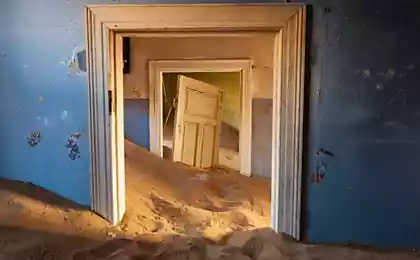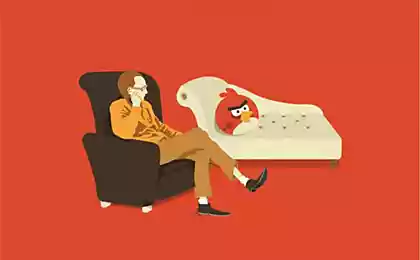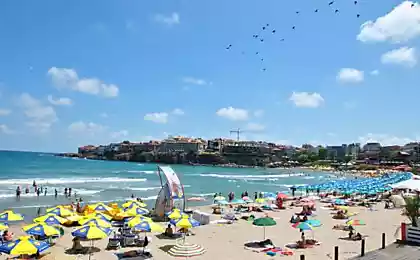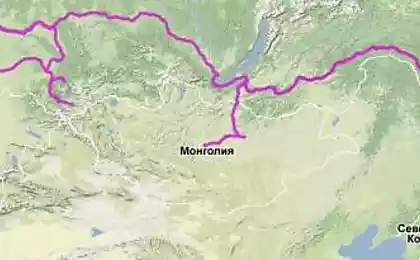1112
What is quicksand (3 photos)
Surely each of us heard what quicksand. But it is unlikely many will be able to really talk about them. For example: how they work, what properties are, why they are so dangerous and how much they are dangerous. In this post I will try to tell the most interesting moments.

Undoubtedly, quicksand - one of the most dangerous places on Earth. Typically, the sun dries the upper layer of sand, whereby it forms a thin solid crust, which may even have time to grow grass. But the illusion of reliability instantly evaporate, it is only a step - literally float ground from under his feet. Poor souls to walk on the sand, seemingly solid ground, instantly sucked. Legs are clenched solidified mass, and pull them out without assistance is impossible.
By itself, quicksand can not kill a man. Firstly, it can not fully absorb the person, because it is a non-Newtonian fluid. However, if the person can not be saved in time, he may die of some other cause. For example, dehydration, sun exposure, different animals, or die under water tide, as it happened with Adrean Dixon.
It has been suggested many theories about the phenomenon of shifting sands. Most of them, of course, turned out to be erroneous. However, with time the situation became clearer. It was found that the properties of wet sand considerably depends on the amount of water contained therein. Moist grains stick together easily, showing a sharp increase in the cohesive forces, which are caused by a dry sand surface irregularities, and therefore very small. The surface tension of water films surrounding each grain of sand make them stick together among themselves. Grains from sticking to a well, the water should cover the particles and their groups by a thin film, and the greater part of the space between them should be filled with air. If the amount of water in the sand to increase, then, as soon as the space between the grains of sand filled with water, the surface tension will be gone and a mixture of sand and water, which has completely different properties. Thus, quicksand - it is the most common sand, under a layer which is at a depth of a few meters there is a sufficiently strong source of water.

Why does a person falls into the quicksand? It's all about the location of the special structure of grains of sand. Going below the water flow churns loose pillow of sand grains, which is in relative equilibrium until some time now. Weight wandered to a place a traveler brings down the structure. Grits, redistributing move with the body of the victim further if sucked in poor soil. After that, the structure of sand around the accident becomes quite another - firmly pressed wet grit due to the surface tension of the water layer forming a trap. If you try to pull the leg formed discharge air with great force pulling the leg back. To pull the leg in such a situation at a speed 0, 1 m / s, it is necessary to apply a force equal to the lifting force of a passenger car of medium size. So, when released into the quicksand is better not to make any sudden movements, and try to lie on your back and arms outstretched, waiting for help.
Rumor has it that in the Sahara, through the fault of the quicksand, and sometimes disappear caravans. Nomads of the tribe of the Tuareg story about the harrowing screams wafting in the night out of the ground. They believe that this moaning souls absorbed greedy belly of the desert. Recently, Russian scientists have made a discovery based on photographs of the Earth surface of the satellite, - under the desert flows a powerful underground river. Perhaps this flow of water and give some places the desert properties zybuchesti.

It is difficult to even roughly estimate the number of victims of the deadly sands, anyway, it exceeds the thousands and perhaps tens of thousands. In 1692, Jamaica quicksand swallowed whole area of Port-Royal, then killed more than two thousand people. Port Royal was a very wealthy large port, which was the largest slave market. From 1674 on the appointment of King Charles II of England mayor was famous pirate Henry Morgan. However, the place for the construction of the city was chosen so poorly - Port Royal was located on the 16-kilometer spit of sand. Its top layer is still saturated with water, and below is a mixture of gravel, sand and fragments of rock.

Undoubtedly, quicksand - one of the most dangerous places on Earth. Typically, the sun dries the upper layer of sand, whereby it forms a thin solid crust, which may even have time to grow grass. But the illusion of reliability instantly evaporate, it is only a step - literally float ground from under his feet. Poor souls to walk on the sand, seemingly solid ground, instantly sucked. Legs are clenched solidified mass, and pull them out without assistance is impossible.
By itself, quicksand can not kill a man. Firstly, it can not fully absorb the person, because it is a non-Newtonian fluid. However, if the person can not be saved in time, he may die of some other cause. For example, dehydration, sun exposure, different animals, or die under water tide, as it happened with Adrean Dixon.
It has been suggested many theories about the phenomenon of shifting sands. Most of them, of course, turned out to be erroneous. However, with time the situation became clearer. It was found that the properties of wet sand considerably depends on the amount of water contained therein. Moist grains stick together easily, showing a sharp increase in the cohesive forces, which are caused by a dry sand surface irregularities, and therefore very small. The surface tension of water films surrounding each grain of sand make them stick together among themselves. Grains from sticking to a well, the water should cover the particles and their groups by a thin film, and the greater part of the space between them should be filled with air. If the amount of water in the sand to increase, then, as soon as the space between the grains of sand filled with water, the surface tension will be gone and a mixture of sand and water, which has completely different properties. Thus, quicksand - it is the most common sand, under a layer which is at a depth of a few meters there is a sufficiently strong source of water.

Why does a person falls into the quicksand? It's all about the location of the special structure of grains of sand. Going below the water flow churns loose pillow of sand grains, which is in relative equilibrium until some time now. Weight wandered to a place a traveler brings down the structure. Grits, redistributing move with the body of the victim further if sucked in poor soil. After that, the structure of sand around the accident becomes quite another - firmly pressed wet grit due to the surface tension of the water layer forming a trap. If you try to pull the leg formed discharge air with great force pulling the leg back. To pull the leg in such a situation at a speed 0, 1 m / s, it is necessary to apply a force equal to the lifting force of a passenger car of medium size. So, when released into the quicksand is better not to make any sudden movements, and try to lie on your back and arms outstretched, waiting for help.
Rumor has it that in the Sahara, through the fault of the quicksand, and sometimes disappear caravans. Nomads of the tribe of the Tuareg story about the harrowing screams wafting in the night out of the ground. They believe that this moaning souls absorbed greedy belly of the desert. Recently, Russian scientists have made a discovery based on photographs of the Earth surface of the satellite, - under the desert flows a powerful underground river. Perhaps this flow of water and give some places the desert properties zybuchesti.

It is difficult to even roughly estimate the number of victims of the deadly sands, anyway, it exceeds the thousands and perhaps tens of thousands. In 1692, Jamaica quicksand swallowed whole area of Port-Royal, then killed more than two thousand people. Port Royal was a very wealthy large port, which was the largest slave market. From 1674 on the appointment of King Charles II of England mayor was famous pirate Henry Morgan. However, the place for the construction of the city was chosen so poorly - Port Royal was located on the 16-kilometer spit of sand. Its top layer is still saturated with water, and below is a mixture of gravel, sand and fragments of rock.























